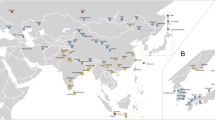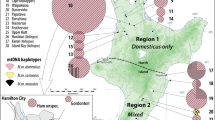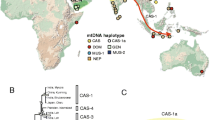Abstract
Mitochondrial DNA control region of Mus terricolor, three aboriginal species M. spretus, M. macedonicus, M. spicilegus; the Asian lineage M. caroli, M. cervicolor, M. cookii; and the two house mice, M. musculus domesticus and M. m. castaneus were analysed to estimate the substitution rate, phylogenetic relationship and the probable time of divergence. Results showed that M. spretus, M. caroli and M. terricolor are highly diverged from each other (caroli/terricolor = 0.146, caroli/spretus = 0.147 and terricolor/spretus = 0.122), whereas M. spretus showed less divergence with two house mice species (0.070 and 0.071). Sequence divergence between M. terricolor and the Palearctic group were found to be ranging from 0.121 to 0.134. Phylogenetic analysis by minimum evolution, neighbour-joining, unweighed pair group method with arithmetic mean and maximum parsimony showed almost similar topology. Two major clusters were found, one included the Asian lineage, M. caroli, M. cookii and M. cervicolor and the other included the house mice M. m. domesticus, M. m. castaneus and the aboriginal mice M. macedonicus and M. spicilegus along with M. spretus, forming the Palearctic clade. M. terricolor was positioned between the Palearctic and Asian clades. Results showed that Palearctic-terricolor and the Asian lineages diverged 5.47 million years ago (Mya), while M. terricolor had split around 4.63 Mya from their ancestor. M. cervicolor, M. cookii and M. caroli diverged between 4.70 and 3.36 Mya, which indicates that M. terricolor and the Asian lineages evolved simultaneously. M. spretus is expected to have diverged nearly 2.9 Mya from their most recent common ancestor.





Similar content being viewed by others
References
Auffray J.-C., Orth A., Catalan J., Gonzalez J.-P., Desmarias E. and Bonhomme F. 2003 Phylogenetic position and description of a new species of subgenus Mus (Rodentia, Mammalia) from Thailand. Zool. Scr. 32, 119–127.
Baker R. J., Haiduk M. W., Robbins L. W., Cadena A. and Koop B. F. 1982 Chromosomal studies of south American bats and their systematic implications. In Mammalian biology in south (ed. M. A. Mares and H. H. Genoways), pp. 303–327. Pymatuning Lab Ecol., University Pittsburgh, Pittsburgh.
Benton M. J. and Donoghue P. 2007 Paleontological evidence to date the tree of life. Mol. Biol. Evol. 24, 26–53.
Benveniste R. E., Callahan R., Sherr C. J., Chapman V. and Todaro G. J. 1977 Two distinct endogenous type C viruses isolated from the Asian rodent Mus cervicolor: conservation of virogene sequences in related rodent species. J. Virol. 21, 849–862.
Bonhomme F., Martin S. and Thaler L. 1978 Hybridization between Mus musculus L. and Mus spretus Lataste under laboratory conditions. Experientia 34, 1140–1141.
Bonhomme F., Catalan J., Guerassimov S., Orsini P. and Thaler L. 1983 Le complexe d’espèces du genre en Europe Centrale et Orientale. 1. Genetique. Z. Saugetierkd. 48, 78–85.
Bonhomme F., Orth A., Cucchi T., Rajabi-Maham H., Catalan J., Boursot P. et al. 2011 Genetic differentiation of the house mouse around the Mediterranean basin: matrilineal footprints of early and late colonization. Proc. R. Soc. B 278, 1034–1043.
Boursot P., Auffray J. C., Britton-Davidian J. and Bonhomme F. 1993 The evolution of house mice. Annu. Rev. Ecol. Evol. Syst. 24, 119–152.
Boursot P., Din W., Anand R., Darviche D., Dod B., Von-Deimling F. et al. 1996 Origin and radiation of the house mouse: mitochondrial DNA phylogeny. J. Evol. Biol. 9, 391–415.
Britten R. J. 1986 Rates of DNA sequence evolution differ between taxonomic groups. Science 231, 1393–l398.
Brownell E. 1983 DNA/DNA hybridization studies of muroid rodents: symmetry and rates of molecular evolution. Evolution 37, 1034–1051.
Chatterjee B. and Rao G. R. 1984 A simple method for purification of mtDNA. Indian J. Biochem. Biophys. 21, 378–380.
Chatterjee B., Bahadur M. and Sharma T. 1994 Mitochondrial DNA restriction maps of Mus booduga, Mus terricolor and Mus musculus tytleri. J. Genet. 73, 57–64.
Chevret P., Veyrunes F. and Britton-Davidian J. 2005 Molecular phylogeny of the genus Mus (Rodentia: Murinae) based on mitochondrial and nuclear data. Biol. J. Linn. Soc. 84, 417–427.
Din W., Anand R., Boursot P., Darviche D., Dod B., Jouvin-Marche E. et al. 1996 Origin and radiation of the house mouse: clues from nuclear genes. J. Evol. Biol. 9, 519–539.
Felsenstein J. 1985 Confidence limits on phylogenies: an approach using the bootstrap. Evolution 39, 783–791.
Flynn L. J., Jacobs L. L. and Lindsay E. H. 1985 Problems in muroid phylogeny: relationships to other rodents and origin of major groups. In Evolutionary relationships among rodents: a multidisciplinary analysis (ed. W. P. Luckett and J. L. Hartenberger), pp. 589–616. Plenum Press, New York, USA.
Fort P., Bonhomme F., Darlu P., Piechaczyk M., Jeanteur P. and Thaler L. 1985 Clonal divergence of mitochondrial DNA versus populational evolution of nuclear genome. Evol. Theor. 7, 81–90.
Galewski T., Tilak M., Sanchez S., Chevret P., Paradis E. and Douzery E. 2006 The evolutionary radiation of Arvicoline rodents (voles and lemming): relative contribution of nuclear and mitochondrial DNA phylogenies. BMC Evol. Biol. 6, 80.
Geraldes A., Basset P., Gibson B., Smith K., Harr B., Yu H. T. et al. 2008 Inferring the history of speciation in house mice from autosomal, X-linked, Y-linked and mitochondrial genes. Mol. Ecol. 17, 5349–5363.
Guénet J. L. and Bonhomme F. 2003 Wild mice: an ever-increasing contribution to a popular mammalian model. Trends Genet. 19, 24–31.
Hasegawa M., Cao Y. and Yang Z. 1998 Preponderance of slightly deleterious polymorphism in mitochondrial DNA: nonsynonymous/synonymous rate ratio is much higher within species than between species. Mol. Biol. Evol. 15, 1499–1505.
Huchon D., Catzeflis F. M. and Douzery E. J. P. 2000 Variance of molecular datings, evolution of rodents, and the phylogenetic affinities between Ctenodactylidae and Hystricognathi. Proc. R. Soc. Lon. B 267, 393–402.
Ingman M., Kaessmann H., Pabbo S. and Gyllensten U. 2000 Mitochondrial genome variation and the origin of modern humans. Nature 408, 708–713.
Jacobs L. L. 1978 Fossil rodents (Rhyzomyidae and Muridae) from Neogene Siwalik deposits, Pakistan. Mus. Nort. Arizona Press Bull. Ser. 52, 1–103.
Jacobs L. L. and Pilbeam D. 1980 Of mice and men: fossil based divergence dates and molecular “clocks”. J. Hum. Evol. 9, 551–555.
Jacobs L. L. and Downs W. R. 1994 The evolution of murine rodents in Asia. In Rodent and lagomorph families of Asian origin and diversification (ed. Y. Tomida, D. Li and T. Setoguchi), pp. 149–156. Monograph, National Science Museum, Tokyo.
Lee M. R. and Elder F. F. B. 1980 Yeast stimulation of bone marrow mitoses for cytogenetic investigations. Cytogenet. Cell Genet. 26, 36–40.
Lundrigan B. L., Jansa S. A. and Tucker P. K. 2002 Phylogenetic relationships in the genus Mus, based on paternally, maternally, and biparentally inherited characters. Syst. Biol. 51, 410–431.
Macholan M., Mrkvicova V. M., Bejcek V. and Stastny K. 2012 Mitochondrial DNA sequence variation and evolution of world house mice (Mus musculus). Folia Zool. 61, 284–307.
Mahler K. L., Fleming J. L., Dworkin A. M., Gladman N., Cho H.-Y., Mao J.-H. et al. 2008 Sequence divergence of Mus spretus and Mus musculus across a skin cancer susceptibility locus. BMC Genomics 9, 626.
Manjunatha K. A. and Aswathanarayana N. V. 1979 Studies on chromosomes of the genus Mus: autosomal polymorphism in the Indian pygmy mouse Mus dunni (Wroughton). Curr. Sci. 48, 657–659.
Markvong A., Marshall T., Pathak S. and Hsu T. C. 1975 Chromosomes and DNA of Mus: the karyotype of Mus flavidiventris and Mus dunni. Cytogenet. Cell Genet. 14, 116–125.
Matthey R. and Petter F. 1968 Existence de deux especes distinctes, l’une chromosomiquement polymorphe chez der Mus indiens der groups booduga. Etude cytogenetique et taxonomique. Rev. Suisse Zool. 75, 461–498.
Musser G. G. and Carleton M. D. 1993 Family Muridae. In Mammal species of the world: a taxonomic and geographic reference, 2nd edition (ed. D. E. Wilson and D. M. Reeder), pp. 501–756. Smithsonian Institution, Washington, USA.
Musser G. G. and Carleton M. D. 2005 Superfamily Muroidea. In Mammal species of the world a taxonomic and geographic reference (ed. D. E. Wilson and D. M. Reeder), pp. 894–1531. Johns Hopkins University Press, Baltimore, USA.
Nei M. and Kumar S. 2000 Molecular evolution and phylogenetics. Oxford University Press, New York, USA.
Phifer-Rixey M., Bonhomme F., Boursot P., Churchill G. A., Pialek J., Tucker P. K. and Nachman M. W. 2012 Adaptive evolution and effective population size in wild house mice. Mol. Biol. Evol. 29, 2949–2955.
Prager E. M., Tichy M. H. and Sage R. D. 1996 Mitochondrial DNA sequence variation in the eastern house mouse, Mus musculus: comparison with other house mice and report of a 75-bp tandem repeat. Genetics 143, 427–446.
Prager E. M., Orrego C. and Sage R. D. 1998 Genetic variation and phylogeography of central Asian and other house mice, including a major new mitochondrial lineage in Yemen. Genetics 150, 835–861.
Rice N. R. 1971 Differences in the DNA of closely related rodents. Year B. Carnegie Inst. Wash. 70, 366–369.
Rudra M. and Bahadur M. 2013 Heterochromatin variation among the populations of Mus terricolor Blyth, 1851 (Rodentia, Muridae) chromosome type I. Comp. Cytogen. 7, 139–151.
Rzhetsky A. and Nei M. 1992 A simple method for estimating and testing minimum evolution trees. Mol. Biol. Evol. 9, 945–967.
Sage R. D. 1981 Wild mice. In The mouse in biomedical research, vol. 1. History, genetics and wild mice (ed. H. L. Foster, J. D. Small and J. G. Fox), pp. 39–90. Academic Press, New York, USA.
Sage R. D., Atchley W. R. and Capanna E. 1993 House mice as a model in systematic biology. Syst. Biol. 42, 523–561.
Saitou N. and Nei M. 1987 The neighbor-joining method: a new method for reconstructing phylogenetic trees. Mol. Biol. Evol. 4, 406–425.
Sen S. and Sharma T. 1983 Role of constitutive heterochromatin in evolutionary divergence: results of chromosome banding and condensation inhibition studies in Mus musculus, Mus booduga and Mus dunni. Evolution 37, 628–636.
Sharma T. 1996 Chromosomal and molecular divergence in the Indian pygmy field mice Mus booduga–terricolor lineage of the subgenus Mus. Genetica 97, 331–338.
Sharma T. and Garg G. S. 1975 Constitutive heterochromatin and karyotype variation in Indian pygmy mouse, Mus dunni. Genet. Res. 25, 189–191.
Sharma T., Cheong N., Sen P. and Sen S. 1986 Constitutive heterochromatin and evolutionary divergence of Mus dunni, Mus booduga and Mus musculus. Curr. Top. Microbiol. Immunol. 127, 35–44.
Sharma T., Balajee A. S. and Cheong N. 1990 Chromosomal speciation: constitutive heterochromatin and evolutionary differentiation of the Indian pygmy field mice. In Trends in chromosome research (ed. T. Sharma), pp. 265–283. Springer-Verlag and Narosa Publishing House, New Delhi, India.
She J. X., Bonhomme F., Boursot P., Thaler L. and Catzeflis F. 1990 Molecular phylogenies in the genus Mus – comparative analysis of electrophoretic, scnDNA hybridization, and mtDNA RFLP data. Biol. J. Linn. Soc. 41, 83–103.
Smith M. F. and Patton J. L. 1999 Phylogenetic relationships and the radiation of sigmodontine rodents in south America: evidence from cytochrome b. J. Mamm. Evol. 6, 89–128.
Sneath P. H. A. and Sokal R. R. 1973 Numerical taxonomy. Freeman, San Francisco, USA.
Spradling T., Hafner M. and Demastes J. 2001 Differences in rate of cytochrome-b evolution among species of rodents. J. Mammal 82, 65–80.
Stoneking M., Sherry S. T., Redd A. J. and Vigilant L. 1992 New approaches to dating suggest a recent age for the human mtDNA ancestor. Phil. Trans. R. Soc. Lon. B 337, 167–175.
Suzuki H., Shimada T., Terashima M., Tsuchiya K. and Aplin K. 2004 Temporal, spatial, and ecological modes of evolution of Eurasian Mus based on mitochondrial and nuclear gene sequences. Mol. Phylogenet. Evol. 33, 626–646.
Suzuki H., Nunome M., Inoshita G., Aplin K. P., Vogel P., Kryukov A. P. et al. 2013 Evolutionary and dispersal history of Eurasian house mice Mus musculus clarified by more extensive geographic sampling of mitochondrial DNA. Heredity 111, 375–390.
Tajima F. 1993 Simple methods for testing molecular clock hypothesis. Genetics 135, 599–607.
Tamura K. and Nei M. 1993 Estimation of the number of nucleotide substitutions in the control region of mitochondrial DNA in humans and chimpanzees. Mol. Biol. Evol. 10, 512–526.
Tamura K., Nei M. and Kumar S. 2004 Prospects for inferring very large phylogenies by using the neighbor-joining method. Proc. Natl. Acad. Sci. USA 101, 11030–11035.
Tamura K., Dudley J., Nei M. and Kumar S. 2007 MEGA 4: molecular evolutionary genetics analysis (MEGA) software version 4.0. Mol. Biol. Evol. 24, 1596–1599.
Tamura K., Peterson D., Peterson N., Stecher G., Nei M. and Kumar S. 2011 MEGA5: Molecular Evolutionary Genetics Analysis using maximum likelihood, evolutionary distance, and maximum parsimony methods. Mol. Biol. Evol. 28, 2731–2739.
Thompson J. D., Higgins D. G. and Gibson T. J. 1994 CLUSTAL W: improving the sensitivity of progressive multiple sequence alighnment through sequence weighing, position-specific gap penalties and weight matrix choice. Nucleic Acids Res. 22, 4673–4680.
Tucker P. K. 2007 Systematics of the genus Mus. In The mouse in Biomedical Research, 2nd edition (ed. J. G Fox, S. W. Barthold, M. T. Davisson, C. E. Newcomer, F. W. Quimby and A. L. Smith), pp. 13–23. American College of Laboratory, Animal Medicine Series, Elsevier Press, Boston.
Tucker P. K., Lee B. K. and Eicher E. M. 1989 Y chromosome evolution in the subgenus Mus (genus Mus). Genetics 122, 169–179.
Tucker P. K., Sandstedt S. and Lundrigan B. L. 2005 Phylogenetic relationships in the genus Mus: examining gene trees and species trees. Biol. J. Linn. Soc. 84, 653–662.
Wu C.-I. and Li W. H. 1985 Evidence for higher rates of nucleotide substitution in rodents than in man. Proc. Natl. Acad. Sci. USA 2, 1741–1745.
Yonekawa H., Moriwaki K., Gotoh O., Hayashi J.-I., Watanabe J., Miyashita N. et al. 1981 Evolutionary relationships among five subspecies of Mus musculus based on restriction enzyme cleavage patterns of mitochondrial DNA. Genetics 98, 801–816.
Yonekawa H., Sato J. J., Suzuki H. and Moriwaki K. 2012 Origin and genetic status of Mus musculus molossinus: a typical example of reticulate evolution in the genus Mus. In Evolution of the house mouse. Cambridge studies in morphology and molecules: new paradigms in evolutionary biology (ed. M. Macholán, S. J. E. Baird, P. Munclinger and L. Piálek), pp. 94–113. Cambridge University Press, Cambridge , UK.
Acknowledgements
The financial support received from the University of North Bengal, Rajarammohunpur, Siliguri 734013, West Bengal, India, routed through the Department of Zoology is sincerely acknowledged. The DNA of M. caroli and M. spretus received from the Jackson Laboratory is gratefully acknowledged. The authors gratefully acknowledge Prof Ananda Mukhopadhyay, Department of Zoology, University of North Bengal for editing the manuscript with valuable suggestions on language.
Author information
Authors and Affiliations
Corresponding author
Additional information
[Rudra M., Chatterjee B. and Bahadur M. 2016 Phylogenetic relationship and time of divergence of Mus terricolor with reference to other Mus species. J. Genet. 95, xx–xx]
Electronic supplementary material
Below is the link to the electronic supplementary material.
Rights and permissions
About this article
Cite this article
RUDRA, M., CHATTERJEE, B. & BAHADUR, M. Phylogenetic relationship and time of divergence of Mus terricolor with reference to other Mus species. J Genet 95, 399–409 (2016). https://doi.org/10.1007/s12041-016-0654-x
Received:
Revised:
Accepted:
Published:
Issue Date:
DOI: https://doi.org/10.1007/s12041-016-0654-x




